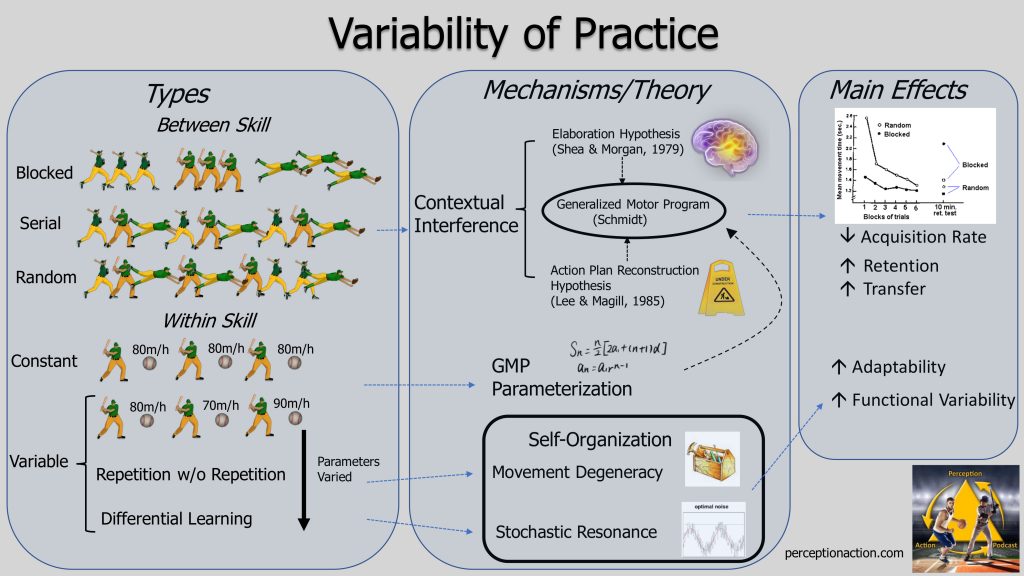
Overview: “Schmidt and colleagues directed attention towards the suggestion that performance on a novel task will be better following varied, rather than constant, prior practice. This suggestion was termed the ‘variability of practice hypothesis’ by Moxley (1979) – a label that has since that time become generally adopted. This hypothesis proposes that not all practice is equally efficient in improving motor control; the claim being that variable (i.e. continually changing) practice in contrast to constant (i.e. always the same) practice leads to superior learning”. van Rossum 1990
Key Terminology & Definitions:
–Between-Skill Variability – Switching between different skills within a practice session E.g., Serving, forehands and backhands in tennis OR chipping, putting and driving in golf. There are 3 basic ways between-skill variability can be manipulated in practice:

1)Blocked practice – practicing by performing the different skills in blocks, that is several repetitions of one skill before shifting to the next. E.g., 15 serves followed by 15 forehands followed by 15 backhands.
2)Random practice – practicing by switching between the different skills in a random order such that the order is unpredictable to the athlete. E.g., 1 serve, 2 forehands, 1 backhand, 2 serves, etc.
3)Serial practice – practicing by switching between the different skills in a structured, predictable order. E.g., 1 serve, 1 forehand, 1 backhand, 1 serve, 1 forehand, 1 backhand, etc….
–Within-Skill Variability – Switching between variants of the same skill within a practice session E.g. shooting a jump shot from 10, 15 and 20 feet in basketball OR hitting an iron shot from a flat, downhill and uphill lie in golf. There are 4 basic ways that within-skill variability can be manipulated in practice:

1)Constant practice – practicing by repeating the same variant of the skill over and over eg., 20 iron shots from the same distance and lie.
2)Variable practice – practicing by varying one parameter of the skill from execution to execution (in either a structured or random manner). E.g. switching between different lies in golf, distances in basketball shooting or pitch speeds in baseball batting.
3)”Repetition without repetition” – practicing be varying multiple parameters of a skill from execution to execution by presenting the athlete with different movement problems to solve E.g., downhill lie from 20 feet, uphill lie into the wind in the rough, etc…
4)Differential learning – practicing by varying multiple parameters of a skill from execution to execution by instructing the athlete to execute the skill in different pre-defined ways E.g. different stance widths, different club lengths, with one eye closed, hands different widths apart on the club etc. **Note: this only one type of DL – see the Differential Learning resource page for more detail.
*Based on these definitions, strict repetition or isolated drilling in practice is blocked, constant practice.
Key Research Findings:
**NOTE #1: The effects we are trying to explain here are “variability of practice” effects NOT “Contextual Interference” effects. As will be discussed below, Contextual Interference is a theoretical explanation proposed to explain variability of practice findings. These two are conflated in many articles.
**NOTE #2: There are also many studies out there that don’t distinguish within and between skill variation so they say “blocked vs random” when they really manipulated “constant vs variable”
1)Blocked vs Random Practice
In their 1979 study, Shea & Morgan asked participants to perform a task of “knocking down barriers” on a table using their hand. Three separate tasks were created by defining 3 different orders in which they had to be knocked down (e.g., eight rear, left middle, and right front). The blocked group performed 18 trials with the same knock down order before switching to a different one. The random group practiced a randomly chosen sequence of knockdown orders (indicated by the “stimulus lights”). After training, both groups also performed 2 transfer tests with new knockdown orders. The dependent measure was the time taken to complete the task. The figure below shows their apparatus and now famous pattern of results:
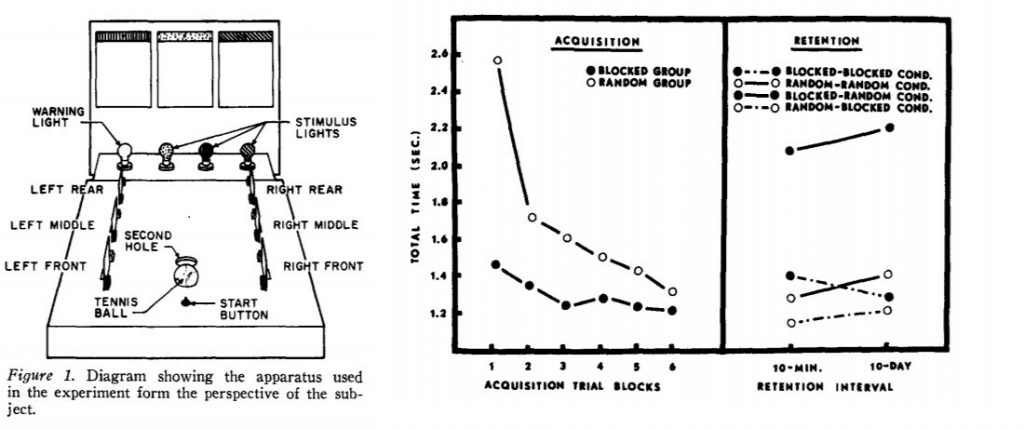
Main Results:
1) Random practice leads to a slower rate of acquisition of the skills as compared to block practice
2) In retention tests, performance for the Blocked group was impaired when asked to now perform the same skills in random conditions
3) Random practice leads to better performance on transfer tests of new skills as compared to Blocked practice (results not shown)
2)Constant vs Variable Practice
Although there have been fewer studies, in general the pattern of results is highly similar: Variable practice leads to slower acquisition but superior retention and transfer to a new task as compared to constant practice. For example, these effects were demonstrated in a study by Shea & Kohl (1990) which required participants to produce movements of different forces and a study by McCraken & Stelmach (1977) which involved variable movement timings.
3)Repetition without Repetition
Research comparing constant practice to training conditions in which multiple parameters of a skill are being varied from execution-to-execution has provided evidence that the latter results in greater performance benefits post-training and a higher level of movement degeneracy, as compared to constant practice. Examples include my 2017 baseball batting study which compared an Adaptive Training group (repetition without repetition in the pitch speed, location and type) with two different types of constant practice (always same pitch within a session, either real or virtual training). The repetition without repetition (VE Adaptive) group had both better batting performance in an on-field test and higher OBP in the full season following the training:
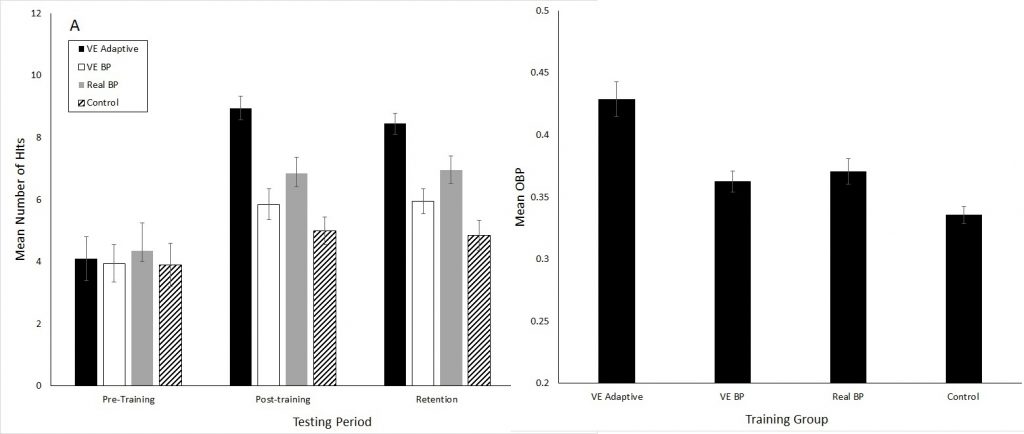
In a 2014 study, Lee et al compared a training group that practiced using repetition without repetition with a group that followed more constant, repetitive practice in tennis. A cluster analysis was used to compare the redundancy in the stroke – more clusters indicated the players were executing the stroke in more different ways. While the number of clusters was similar in the pre-test, there were significantly more clusters for the repetition without repetition group (NP in the figure) in the post-test:
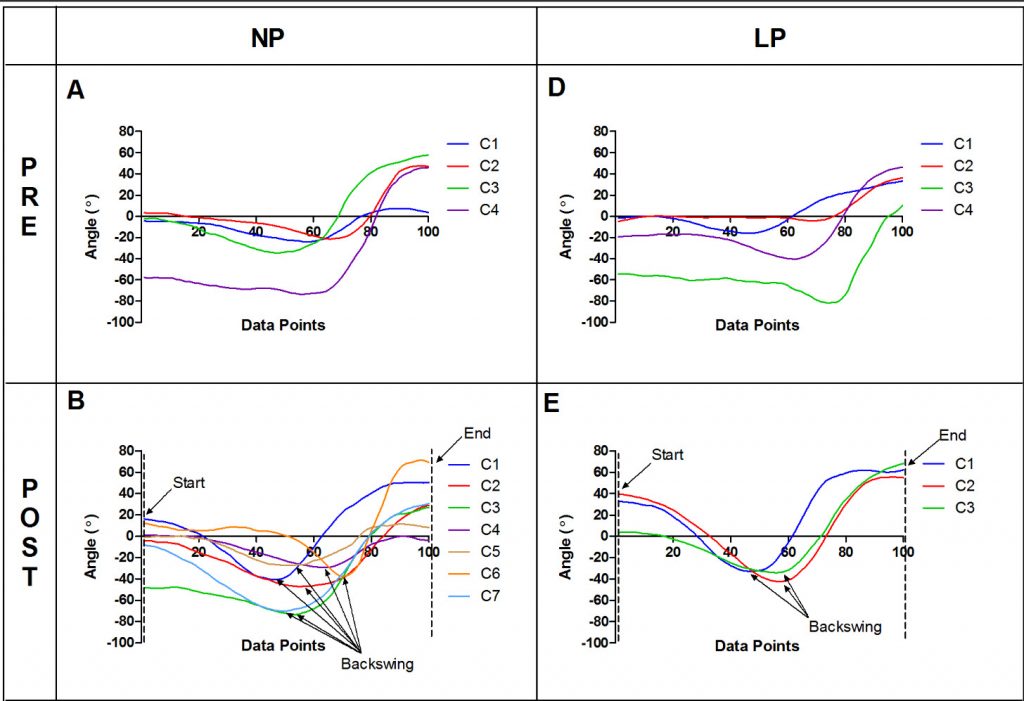
4)Differential Learning
As discussed in detail on this page, a Differential Learning approach of varying multiple parameters has provided evidence for greater post-training performance improvement as compared to traditional, constant practice in sports including speed skating, the shot putt, soccer passing and dribbling, and badminton.
Proposed Theoretical Explanations for Variability of Practice Effects:
The effects of variability of practice can be understood from either an Information Processing or Ecological Approach to skill acquisition.
–The Information Processing Explanation: Contextual Interference & Re-parameterization
The most often discussed theoretical explanations for the differences between blocked vs random practice and constant vs variable practice are based on Schmidt’s Schema Theory of Motor Control. In this theory, our actions are controlled by Generalized Motor Programs (GMP). A GMP contains an abstract representation with invariant features pertaining to the order of events, the relative timing of events and the relative force with which events are produced. In other words it is the basic technique required for a movement stored in an internal model in memory. In order to determine how a particular movement should be performed the specific parameters such as overall movement duration, overall force of contractions and the muscles involved are specified to the GMP.
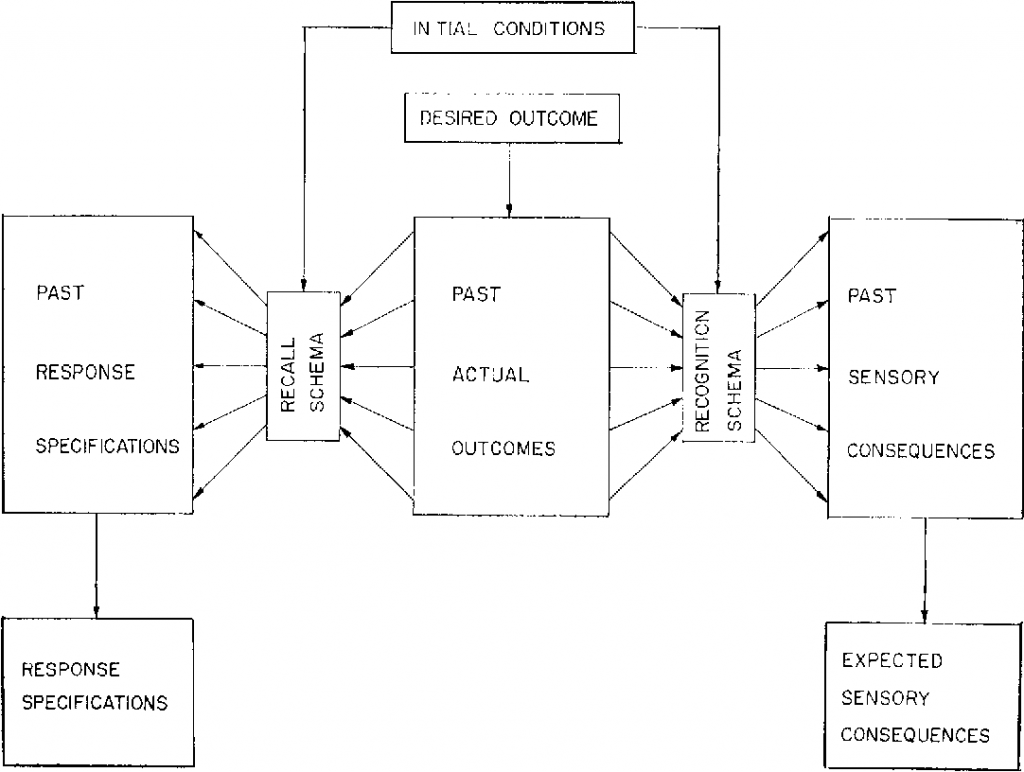
Within this approach, Random practice is thought to induce Contextual Interference. That is, when a performer is developing a GMP for one skill (a serve in tennis) switching to practicing another skill (a backhand) right away will interfere with the development process. The presence of this interference explains why acquisition of the skill is slower under conditions of random practice compared to blocked. The longer-term benefits of random practice (seen in retention and transfer tests) have been explained in terms of two different possible mechanisms:
1) The Elaboration Hypothesis (Shea & Morgan, 1979)
In the Elaboration Hypothesis, it is proposed that random practice allows a performer to develop more elaborate and distinct motor programs. For example, because in random practice a tennis player would be frequently switching back and forth between forehands and backhands, this would allow them to better compare and contrast the two movements, identify the key differences, and develop more distinct GMPs. More elaborate GMPs are thought to allow for better comprehension/understanding of the skill and quicker retrieval of the GMP from memory. In this hypothesis, the comparison between tasks is thought to occur during the interval between the end of the last execution and the start of the next one.
2)The Action Plan Reconstruction Hypothesis (Lee & Magill, 1985).
In the Action Plan Reconstruction Hypothesis (also sometimes called the Forgetting-Reconstruction Hypothesis), it is proposed that random practice forces a performer to abandon (or forget) their action plan (GMP) with each new trial, because they are likely moving to executing a different skill. This required forgetting means that the next time they have to perform that same movement again, they will need to reconstruct the plan they used last time. So for example, on trial #1 I execute a forehand with GMP A. Now on trial #2 I have to do a backhand using GMP B, so I need to forget GMP A. Then on trial #5, when I have to do another forehand, I need to re-assemble GMP A again. This continuous forgetting-reconstruction process is thought to lead to a stronger representation of the task in memory allowing for faster retrieval.
Within all of this is the idea that different amounts of variability in practice will lead to different amounts of Contextual Interference. So interference increases as you go from Blocked- Serial -Random Practice, for example.
–Variable Practice & Parameterization
Within this Schema Theory approach, the benefits of variable practice over constant practice can be understood in terms of parameterizing the GMP. For example, switching the distances or lies of a golf shot from swing to swing requires re-parameterization (setting different forces, durations, timings, etc in the GMP). Thus, after training, the performer can do this parameterization process more quickly and accurately following variable practice. I like to call this developing Adjustability, as I described in this post looking at variability.
–The Ecological Approach Explanations: Movement Redundancy & Stochastic Resonance
In the Ecological Approach, instead of developing adjustability through variability, the benefits of variability of practice are proposed to arise through the development of Adaptability (i.e., developing the ability to solve movement problems in different ways). This comes through two different proposed mechanisms:
1)Movement Degeneracy
Degeneracy, which occurs in large number of biological systems, is the ability of elements that are structurally different to perform the same function or yield the same output. So, for example, in volleyball I can serve the ball using just my shoulder, my shoulder and elbow or my shoulder elbow and wrist, etc. Degeneracy leads to a more robust and adaptable system because if one way of doing it doesn’t work you can switch to others. Varying a large number of movement parameters (repetition without repetition) is thought to promote the development of degeneracy because it is likely the performer will not be able to use the same movement solution for each new problem you create.
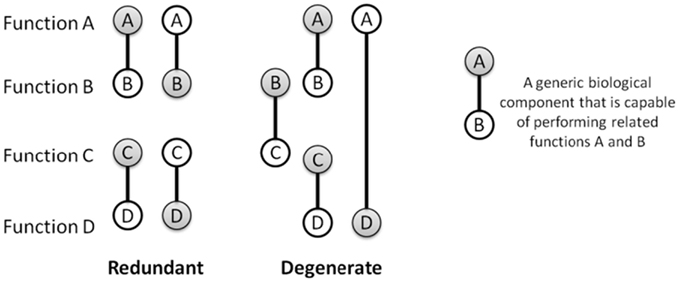
2)Stochastic Resonance
In the theory of Differential Learning it is proposed that adding variability to practice conditions improves performance through a process called stochastic resonance. As explained in detail on my DL resource page, this is the idea that noise (the practice conditions) can be constructive in that it can actually help to strengthen a weak signal (the athlete’s movement pattern). From this viewpoint, blocked or constant practice are likely to have too low amount of noise to promote stochastic resonance.
Some Qualifications to the Classic Findings & Moving Beyond Categories of Variability
As summarized nicely in a chapter published by Farrow & Buszard in 2017 (discussed in podcast episode #91), there are some important limitations to applying the classic variability of practice effects in coaching. The first issue concerns complexity. In the bulk of the research on variability of practice, very simple skills with relative few degrees of freedom have been used, for example tapping out sequences with your fingers on a keyboard. Research which has examined more complex motor skills like those involved in most sports have found much smaller differences between random and blocked practice. For example, in the meta-analysis conducted by Brady in 2004, the average effect size (ES) found in basic, laboratory research studies was .57, while it was only .19 for applied research. For reference, 0.5 is considered to be medium ES while 0.2 is small. It is also the case that cleanly dividing practice into blocked vs random, constant vs variable is not as easy in real world settings. Finally and maybe most importantly, Brady found that age and experience strongly mediate the benefits of variability of practice with random and variable practice being less beneficial for new learners:

These experience effects have led some researchers (e.g. Porter & Beckerman, 2016) to propose that transitioning from blocked to random practice or using serial practice (which has some elements of both) may be more effective for novices and children.
Moving Beyond Categories
In light of these limitations, Farrow, Buzzard and colleagues have proposed that it may be more beneficial to use a continuous metric (which captures both within and between skill variations) to quantify and manipulate practice variability rather than having distinct categories. An example of this concept illustrated for tennis is shown below:
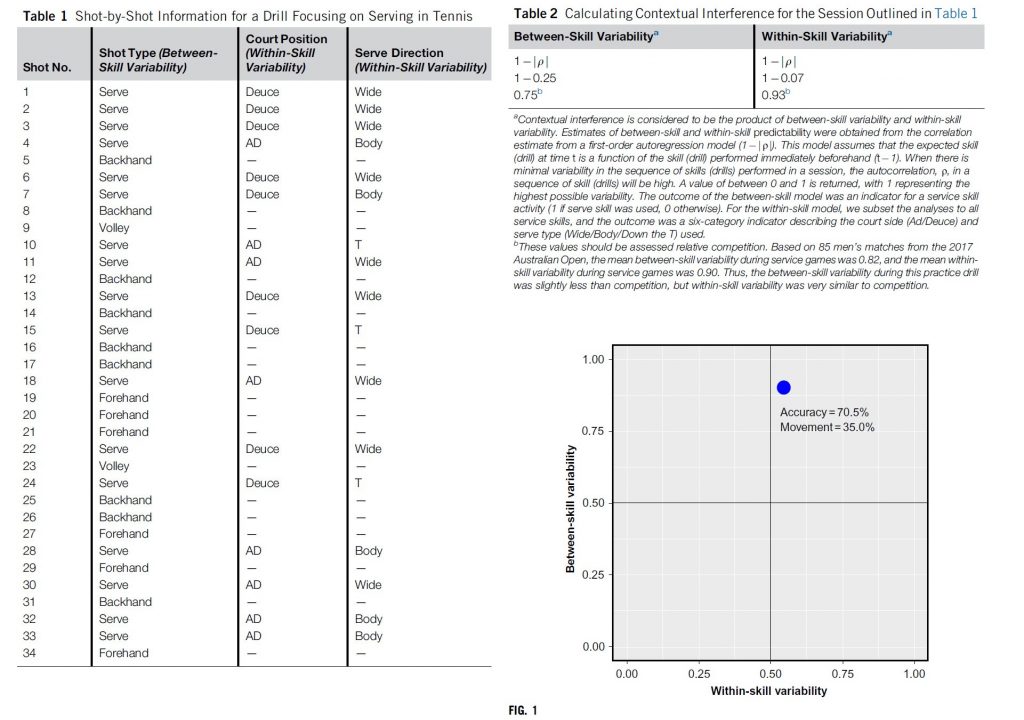
Summary & Conclusions:
No matter which way you slice it or which skill acquisition approach you align yourself with, there are clear, unequivocal benefits to adding variability to practice. To me this is the lowest hanging fruit that still remains in a lot of the practice sessions I observe. However, it is also important to note the the amount of variability you add needs to be appropriate for the skill level and age of the athlete you are coaching. Variability added by practice conditions is going to interact with the variability inherent in the performer themselves (which is generally higher for new learners). So, less variability of practice will typically be better.
Articles
–Schmidt’s schema theory: The empirical base of the variability of practice hypothesis: A critical analysis
–Contextual interference effects on the acquisition, retention, and transfer of a motor skill
–Contextual interference: a meta-analytic study
–Exploring the applicability of the contextual interference effect in sports practice
–Time scales of adaptive behavior and motor learning in the presence of stochastic perturbations
–Changing Up the Routine: Intervention-Induced Variability in Motor Learning
–Neurobiological degeneracy: A key property for functional adaptations of perception and action to constraints
Podcast Episodes:
–9 – Off the Learning Curve: Measuring Skill Acquisition
–91 – Variability of Practice Revisited
–100 – The Why, What, How & When of Movement Variability
–121 – How Much Variability in Practice & When? Does Water Immersion Enhance Motor Learning?
